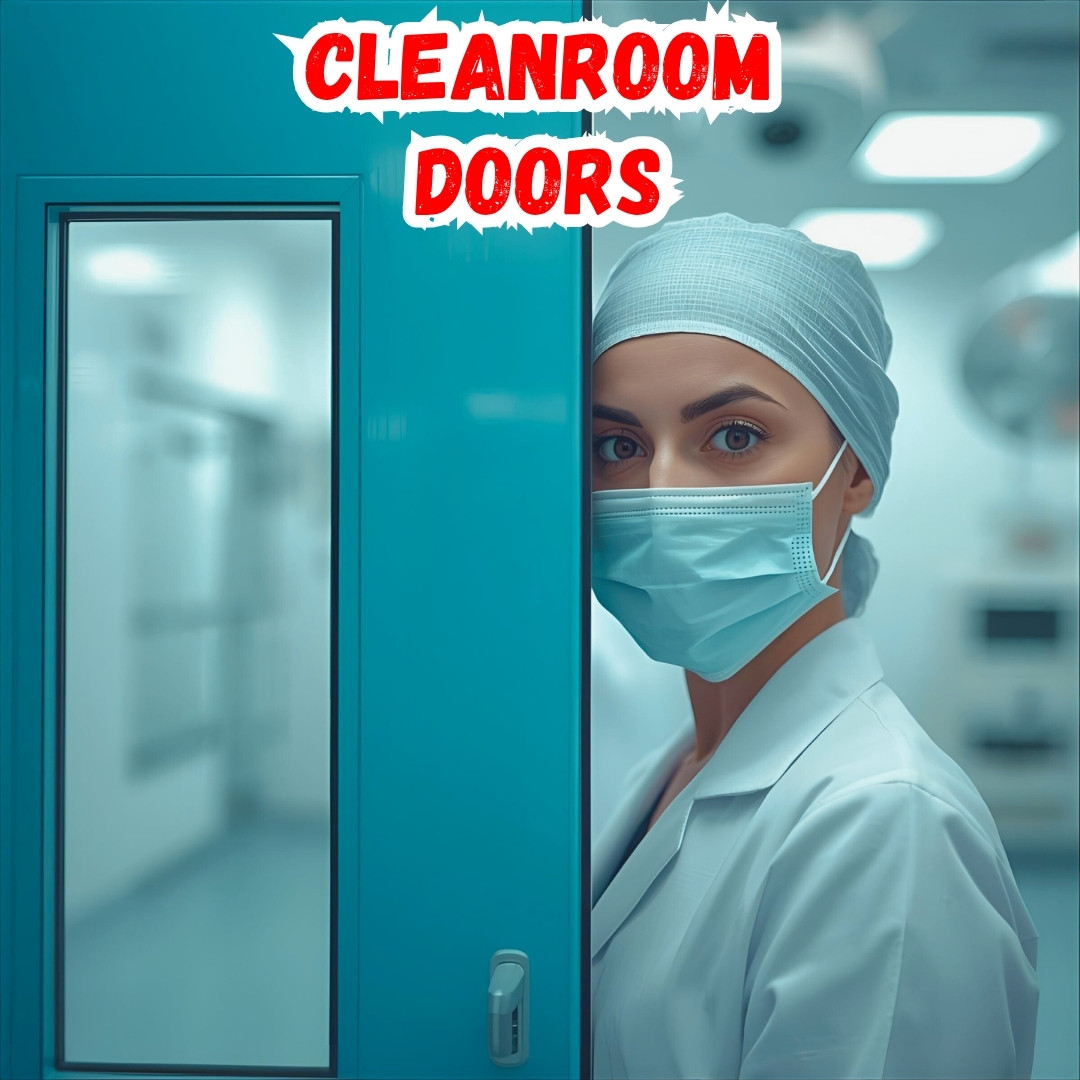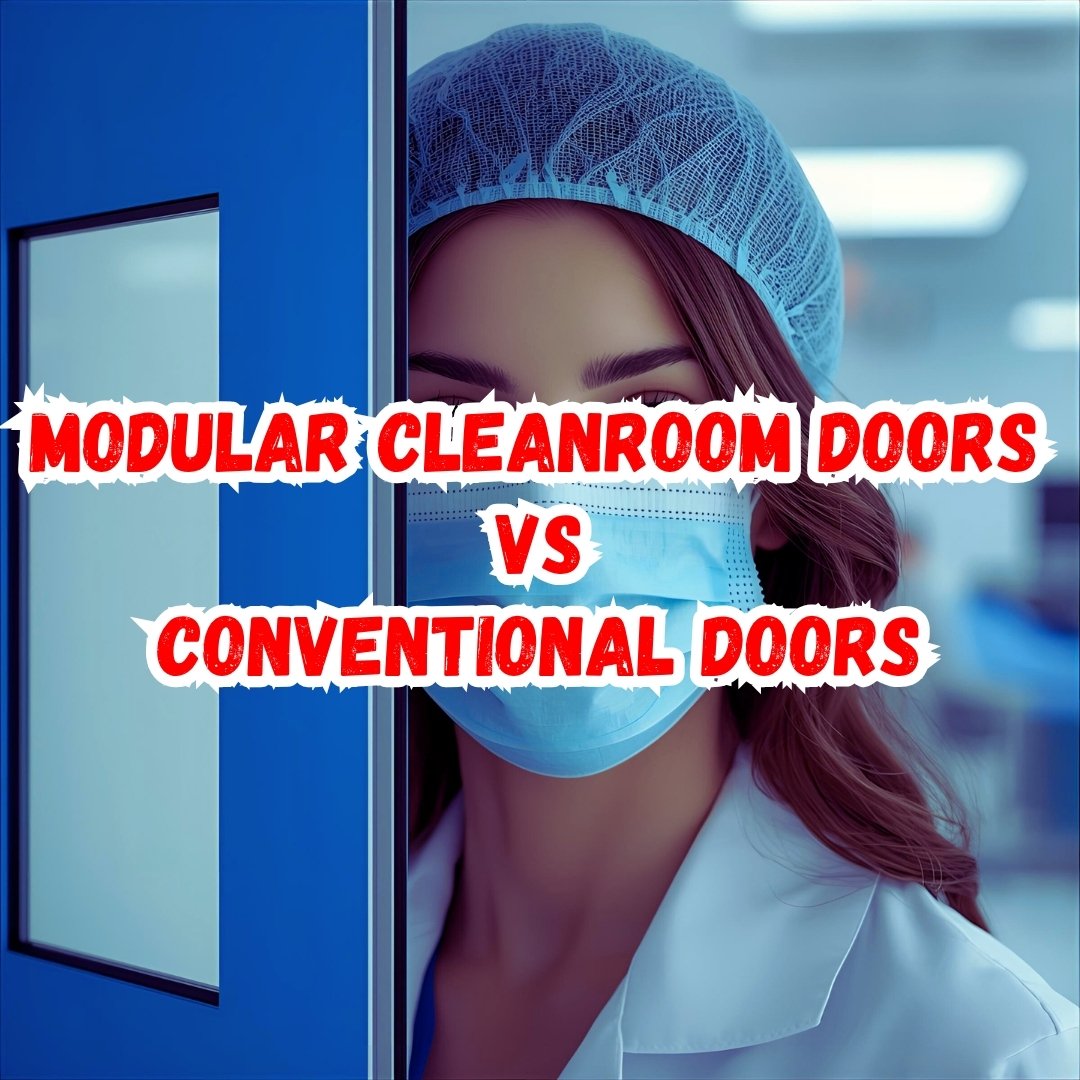
Every hospital administrator, pharma project manager, or cleanroom consultant knows that maintaining air pressure and temperature consistency isn’t just about HVAC systems. The performance of cleanroom doors, Operation Theater doors, and ICU doors often makes the real difference between an optimally controlled environment and one that fails compliance checks.
At first glance, a door seems like a simple barrier — but in a controlled environment such as an Operation Theater, ICU setup, or pharmaceutical cleanroom, the door becomes an active component of the air management system. From maintaining positive pressure in sterile zones to ensuring that temperature and humidity remain stable, door engineering directly impacts patient safety, product quality, and regulatory compliance.
As a leading Operation Theater Door Manufacturer in Ahmedabad, AUM Industries understands this intersection of engineering and hygiene deeply. This article explores the precise role of doors in controlling air pressure and temperature, what makes a good cleanroom or OT door, and why hospitals and pharmaceutical plants across Gujarat and beyond rely on specialized door systems for their turnkey cleanroom solutions.
1. Why Air Pressure Control Matters in Cleanrooms and OTs
Air pressure control is central to contamination prevention. In Operation Theaters and pharmaceutical cleanrooms, the goal is to maintain a pressure gradient — higher pressure in sterile zones and lower pressure in less sterile areas. This positive pressure prevents airborne contaminants from entering critical environments.
Doors play a key role here. Each time a door opens, air can leak and pressure can drop. If the door design doesn’t ensure airtight sealing or if materials conduct too much heat, the entire pressure balance can be disturbed.
For example, in an ICU setup, maintaining differential pressure helps control infection spread. Similarly, in pharma manufacturing, a stable pressure cascade ensures compliance with WHO GMP and NABH standards.
A well-designed Hermetical Door or PUF Insulated Door minimizes leakage, ensuring that airflows only where intended.
Learn more about Operation Theatre & ICU PUF Doors.
Refer to WHO GMP Guidelines for cleanroom classification and air pressure standards.
2. The Science Behind Door Design and Pressure Stability
The moment a door closes, it must act as a seal between two environments — often with significant air pressure difference. To achieve this, manufacturers use several technical design strategies:
- Hermetic sealing systems prevent air leaks, especially around edges.
- PUF (Polyurethane Foam) insulation provides both thermal and acoustic protection.
- Flush-mounted hardware ensures that there are no cavities where particles can accumulate.
- Automatic door closers and interlocks synchronize with HVAC systems to maintain differential pressures.
In an Operation Theater Door, these mechanisms work together to keep the sterile field intact. In cleanrooms, the same principles ensure dust and microbial control.
AUM Industries’ PUF Insulated Doors combine thermal insulation with pressure containment, crucial in HVAC-integrated cleanroom solutions.
Explore PUF Insulated Doors.
Learn about NABH guidelines for air changes and pressure differential.
3. Thermal Stability: How Doors Influence Temperature and Humidity
Air pressure isn’t the only variable that doors affect. Temperature and humidity control is equally critical for infection control and product stability.
When a door opens, conditioned air escapes, leading to fluctuations in both pressure and temperature. A poorly insulated door or a door with metal bridging can allow heat transfer, forcing the HVAC to work harder.
PUF Panels and PUF Doors mitigate this problem. Their high insulation value (low thermal conductivity) maintains the required temperature gradient between sterile and non-sterile zones. In ICUs, this ensures comfort and infection control. In pharma and biotech facilities, it maintains environmental stability as required under GMP.
Read more about Cleanroom Solutions.
Refer to Ministry of Health & Family Welfare guidelines on hospital HVAC standards.
4. Door Material Selection: Function Meets Hygiene
Material selection determines not only durability but also how effectively a door can support controlled conditions.
- Stainless steel cleanroom doors are preferred in pharma and healthcare because of their non-porous, corrosion-resistant nature.
- Powder-coated steel or aluminium OT doors balance cost-effectiveness with hygiene.
- PUF core sandwich doors offer excellent insulation while being lightweight.
The door’s surface must withstand frequent cleaning with disinfectants without degrading. The flush design of Cleanroom Flush Doors eliminates crevices, ensuring microbial containment.
For high-risk zones like operating theatres or BSL cleanrooms, Hermetical Sliding Doors provide superior sealing. These doors also minimize turbulence compared to swinging doors.
Check our Cleanroom Doors.
See WHO technical report on cleanroom materials.
5. Interlocking Doors and Airlocks: Engineering for Pressure Balance
Airlocks with interlocked door systems are essential in critical environments. They act as buffer zones, maintaining pressure differentials between adjoining areas.
When one door of the airlock is open, the other remains closed automatically, ensuring no direct mixing of air. This mechanism depends entirely on door design and sealing quality.
AUM Industries’ Operation Theater Doors and ICU Doors can be integrated with airlock control panels and interlocks — ideal for modular OTs and pharmaceutical manufacturing lines.
Learn about Modular Operation Theatres.
Refer to NABH Accreditation Standards for Operation Theatres.
6. Fire Safety and Emergency Air Management
Temperature and pressure control must coexist with safety. Fire Exit Doors and Emergency Exit Doors are designed not just for quick evacuation but also to maintain compartmental integrity during emergencies.
High-quality Fire Exit Doors from AUM Industries are tested for fire resistance and smoke control, ensuring that pressure-balanced environments do not compromise fire safety requirements.
Explore Fire Exit Doors.
Refer to National Building Code of India (NBC) fire door requirements.
7. Integration with HVAC and HEPA Filtration Systems
Doors interact constantly with HVAC systems. Improper sealing or leakage can cause HEPA filters to overload, affecting air change rates.
An airtight Cleanroom Door with interlock support helps maintain the designed air changes per hour (ACH), reducing HVAC load and improving energy efficiency.
Whether in an ICU Setup, IVF Lab, or Pharma Cleanroom, these integrations ensure compliance with GMP, NABH, and WHO standards.
Learn about ICU Setup Services.
Review WHO HEPA filtration standards.
8. Local Relevance: Why Hospitals and Pharma Units in Ahmedabad & Gujarat Prefer Specialized Doors
Gujarat is one of India’s leading hubs for healthcare and pharmaceutical manufacturing. With its growing number of super-specialty hospitals, diagnostic labs, and formulation plants, the need for precision-engineered ICU Doors, Operation Theater Doors, and Cleanroom Flush Doors has surged.
As a trusted Operation Theater Door Manufacturer in Ahmedabad, AUM Industries has supplied customized door systems across Gujarat’s hospitals and pharma units. The region’s climate adds another layer of complexity — high humidity and temperature variations demand thermally stable, airtight doors that sustain air pressure integrity.
Whether it’s a Turnkey Project for a new hospital or an ICU expansion, locally manufactured PUF Panel Doors reduce lead times and ensure service accessibility.
Learn about Turnkey Projects.
Check Gujarat FDA guidelines on cleanroom facilities.
9. Best Practices for Selecting Cleanroom and OT Doors
To maintain air pressure and temperature stability effectively, consider the following before selecting doors:
- Choose the right core material – PUF for insulation, honeycomb for strength.
- Check for hermetic sealing – vital for positive-pressure areas.
- Ensure compatibility with HVAC and interlocks.
- Opt for modular, flush designs – easy to clean and maintain.
- Confirm compliance with NABH, GMP, and WHO standards.
Prioritize local service and spares – especially in Ahmedabad and Gujarat for faster maintenance.
AUM Industries provides all these features, ensuring that every Hospital Door and Pharma Door supports your facility’s cleanroom ecosystem.
Explore Products.
Review WHO GMP Facility Layout Guidelines.
10. The Economics of Door Performance
Beyond compliance, quality door systems also make financial sense. Leakage or temperature loss due to poor door design increases HVAC energy costs by up to 20%.
Investing in PUF Insulated Doors and Hermetical Doors reduces operational costs, lowers contamination risks, and extends the lifespan of HVAC components. Over a year, this results in measurable cost savings for hospitals, labs, and pharma plants.
Visit Hospitals & Surgical Centres.
Refer to Bureau of Energy Efficiency (BEE) HVAC optimization guidelines.
FAQs
1. Why is air pressure control critical in Operation Theaters?
Positive pressure prevents contaminated air from entering the sterile zone, ensuring infection control and compliance with NABH standards.
2. How do PUF Doors help maintain temperature in ICUs?
PUF insulation minimizes thermal bridging, keeping ICUs thermally stable while reducing HVAC load.
3. Are hermetically sealed doors necessary for all cleanrooms?
Yes, especially for Class 1000 or higher cleanrooms, hermetical sealing ensures minimal air leakage.
4. What’s the difference between Cleanroom Doors and Hospital Doors?
Cleanroom doors are airtight and flush, designed for particle control, while hospital doors focus more on hygiene and accessibility.
5. Do fire-rated doors affect air pressure control?
No, high-quality Fire Exit Doors can maintain compartmental pressure balance while meeting NBC fire safety standards.
6. How often should cleanroom doors be serviced?
Quarterly inspections ensure seals, hinges, and interlocks function properly without air leakage.
7. Can modular OTs use automatic sliding doors?
Yes, automatic hermetical sliding doors are ideal for modular OTs due to touchless operation and pressure retention.
8. Are these doors compliant with NABH and WHO norms?
Yes, all AUM Industries doors are designed to meet NABH, GMP, and WHO cleanroom compliance.
9. What’s the benefit of sourcing doors from Ahmedabad manufacturers?
Local manufacturers like AUM Industries provide quick customization, faster delivery, and on-site service across Gujarat.
10. How do doors contribute to energy efficiency?
Airtight and insulated doors reduce HVAC load, minimizing energy consumption and improving system life.
Final Thoughts
Air pressure and temperature stability are the lifelines of every controlled environment — from operating theatres to pharmaceutical cleanrooms. The right door system is not just a partition but a vital part of that stability.
With advanced design, airtight sealing, and thermal insulation, AUM Industries helps hospitals and industries build spaces that perform consistently and comply with global standards.
Whether you’re planning a new ICU setup, turnkey cleanroom project, or modular OT, partner with AUM Industries — one of India’s most trusted names in Operation Theater Door manufacturing and cleanroom solutions.






